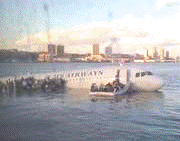Bird Strike Committee Proceedings

Bird Strike Committee-USA/Canada Joint Annual Meeting: 10th (2008)
Date of this Version
8-2008
Document Type
Article
Abstract
Wildlife-aircraft collisions (wildlife strikes) cause serious safety hazards to aircraft and their occupants. Habitat management is an important component of an integrated approach for reducing wildlife use of airports. Species composition of airfield plant communities influences the degree of attractiveness to wildlife. Recent research has shown that grazing Canada geese do not consume endophyte-infected tall fescue, suggesting endophyte-infected tall fescues (Festuca arundinacea) might be favorable turfgrass varieties to use in reseeding and vegetation renovation projects on airfields. As part of a larger study, we conducted an experiment to determine if selected turf-type tall fescue cultivars would establish on the airfield at Marine Corps Air Station Cherry Point, located in coastal North Carolina. Ten tall fescue cultivars (each with high endophyte levels) were seeded into 3 replicated cultivar plots in November of 2005. Establishment and growth of seeded tall fescue varieties were quantified by randomly establishing and sampling 5 0.25-m2 herbaceous sampling plots in each cultivar plot each month during the first (2006) and second (2007) growing seasons following seeding. Overall, tall fescue cover was 34% (range 20 to 57%) and 16% (range 10 to 28%) when averaged across all tall fescue varieties at the end of the first and second growing seasons, respectively. Variation in establishment among the tall fescue varieties was evident after two consecutive growing seasons as some cultivars had higher fescue cover than others. Although tall fescue plants dominated the experimental plots during the spring of 2006, a diversity of native plants (e.g., warm-season grasses) grew into the plots during the intial two growing seasons. The findings from this study suggest commercially available high-endophyte tall fescue cultivars might be useful for re-vegetation projects at Marine Corps Air Station Cherry Point and other similar locations, although methods to control weedy competition during the establishment phase might be necessary.


Comments
Abstract of poster presentation at Bird Strike Committee USA/Canada Meeting, Lake Mary and Sanford, Florida, August 18–21, 2008.